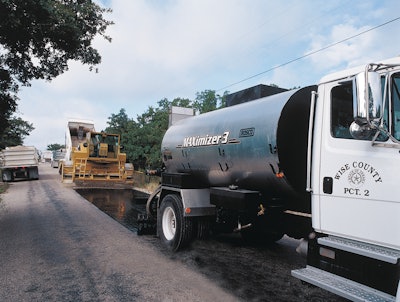
Whether you’re a contractor who focuses on paving and preservation or a contractor who focuses on maintenance, the last few years probably have been a confusing struggle as you worked to help clients maintain pavements within the confines of their budgets while working to grow your own business.
Whether 2012 will bring larger budgets and more work is still to be seen, but there are a number of things happening in the market that will likely affect your 2012 business. Roger Smith, asphalt consultant, presented his view of the 2012 paving and pavement preservation industry in “What’s New in Asphalt Materials: An Overview for 2012” and “Pavement Preservation Strategies for 2012,” two 90-minute sessions at Pavement LIVE, Nov. 30-Dec. 3 in San Diego. Here is some of what he says contractors will be facing this year.
- Maintenance and Preservation vs. Rehabilitation: What’s the Difference? Maintenance involves activities such as cracksealing and any of a variety of surface treatments that do not add structure to the pavement. Rehabilitation, on the other hand, involves major activities such as paving or recycling that do add structure to the pavement.
- Changing Specifications. Smith said all requirements concerning road work are filtered down from the state DOTs and contractors can find specification information in each state’s standard spec book. The spec book is updated and released every few years and, as a result, there are standard special provisions -- accepted specs that haven't been included in the spec book. There are also non-standard special provisions, which is the route new material takes to be added to the spec book. It is the contractor’s responsibility to know these (or know where to find them), and in certain instances some of those specs are finding their way into parking lot construction and maintenance work.
- Understanding the Performance Grade (PG) System. The PG System describes asphalt binders. According to Smith, states and HMA plants use the PG System to determine the high and low temperature at which the binder will best perform. Varying in each state based on its climate, the PG System is a guide for contractors that provides additional information about the material they will be bidding on or placing, so it’s essential that contractors are familiar with it.
- Asphalt Binder Options. Smith said the paving industry currently relies on three general types of asphalt binder (often referred to as asphalt cement). The first is a conventional, unmodified binder found in most hot mix asphalt. A second and increasingly popular binder is asphalt cement modified by polymers, which enhance one or more characteristics of the hot mix. Smith discussed several polymer benefits, including protecting asphalt against higher temperatures, hardening asphalt at higher temperatures and helping resist rutting of pavement. The polymer modifiers are pre-melted into the binder and put in by the refinery. By understanding the materials, contractors can ensure a quality product is used and can better prepare their crew to how to work with each type of material. A third type of binder is asphalt cement that is blended with a small percentage of rubber from ground tires. The ground rubber makes this binder, commonly referred to as asphalt rubber, more elastic, helping the hot mix fight cracking in high or low temperatures. Currently used only in a handful of states including California, Arizona, Florida and Texas, asphalt rubber is something contractors might encounter more frequently, and in some cases states are offering incentives to use this material.
- Reduced Availability of Aggregates. Smith reminded contractors about the diminishing supply of local aggregates. As a result, aggregates are being trucked in from far distances for urban paving, significantly increasing the cost of hot mix asphalt. This reduced aggregate supply has also opened up the door to aggregate alternatives including reclaimed asphalt pavement (RAP), crushed concrete, glass and slag. It is likely contractors will see one or more of these aggregate alternative in future projects.
- Wider Use of Various HMA Mix Types. As technology continues to develop and the market continues to demand a greater variety of paving options, more and more mix designs are becoming available. Each mix type has its specific uses and idiosyncrasies when working with it, so it is essential for contractors to know what to expect from each type and how to work with each mix.
Conventional dense-graded hot mix asphalt. A more conventional mix, dense-graded HMA is used for standard paving. It features aggregate of varying sizes surrounded by fines.
Open-graded Mix. With the open graded mix, the fines are removed and the mix is placed at 1 inch thick to allow rain water to pass through maintaining weather safety.
Gap-graded Mix. Another available mix is the gap-graded mix that contains large proportions of both coarse and fine aggregates with few large voids. Contractors will continue to see the use of gap graded mixes at intersections.
Porous Pavement. With a continued push toward achieving Leadership in Energy and Environmental Design (LEED) points, contractors working on parking lots will likely encounter porous hot mix asphalt. Smith said contractors will see an increase in this open-graded pavement, but he cautioned that this type of pavement can’t be sealcoated because the sealer would fill the pavement’s pores.
- Hot Mix Plants Face Issues. While most Pavement readers are not involved in producing their own hot mix, the plants contractors buy material from are undergoing changes and encountering challenges that will impact paving work. For example, as a result of environmental sensitivity fewer new plants are opening because it’s more difficult to obtain necessary permits. As a result, contractors might have to buy mix from plants located farther from a job. This not only increases haul costs but also requires a greater emphasis on planning and scheduling so there is no downtime on the job. Smith also said that existing plants are faced with monitoring dust management, fume emissions and odor management – all of which could raise the cost of hot mix.
- More Night Paving. While more specifications now require fewer road closures, more and more contractors are completing work at night. In addition to requiring additional equipment such as high-intensity lighting, the impact on a paving contractor can be significant. Crew scheduling, for example, becomes much more complicated when working the occasional night job. And because temperatures drop at night crews are working with temperatures that can lead to challenges with laying down materials.
- Smoothness Becomes More Important. In many cases paving contractors are seeing a growing need for smoothness in specs, especially of a bonus is paid based on smoothness testing. Smith compared direct-dump to windrow paving, emphasizing that contractors can achieve a smoother pavement with windrow paving.
[sidebar with photo]
Keys to a Successful Patch
While quality of work is always essential, it is even more necessary to follow the correct steps when completing patching. An improperly constructed full-depth patch will fail quickly, causing additional and more costly damage to the surrounding pavement. Smith said contractors must always re-compact the base and tack coat the vertical edges of the patch cut. When compacting the hot mix make sure to pinch the edges first and avoid over raking. Smith said that properly constructing a patch will result in a successful, long lasting repair.
SIDEBAR
A Surface Treatment for Every Condition
As cities, counties and property owners look to extend their pavement maintenance dollars, surface treatment options are getting another look. With a variety of options available, contractors must be aware of each surface treatment and the pavement conditions it can be applied on. Here are the surface treatment options you can expect to see more of in 2012.
Fog seals. A fog seal is the simplest treatment, consisting of a light spray of diluted asphalt emulsion directly onto the old pavement surface, Smith says. Contractors need to be aware of the application amount because if they apply too much material it can create a mess on the surface.
Scrub seals. According to Smith, a scrub seal consists of asphalt emulsion, a rejuvenator and a polymer modifier. This process is primarily used on surfaces that have several cracks. There are three basic steps contractors must follow when applying a scrub seal. First, spray the materials on the surface. Then, contractors must drag a broom pushing the material into the cracks. Finally, the process is finished by applying sand or chips.
Chip seals. Chip seals consist of asphalt emulsion and aggregate chips. The process requires an application of a heavy fog seal followed by rock chips, Smith says. According to Smith, the application of a chip seal requires the aggregate to be cleaned allowing it to properly stick. In this process, rubber tired rollers are used to embed the aggregate into the fog seal. It is essential to use the rubber tired rollers because the aggregate must stay at a specific size, and the rubber tired rollers will not crush or break the aggregate.
Slurry seals. Slurry seals are made up of a pre-mix of asphalt emulsion and graded aggregate. There are three gradations of slurry seal available including Type I—fine aggregate with 10-15% residual AC, Type II—general aggregate with 7.5-13.5% residual AC, and Type III—coarse aggregate with 6.5-12% residual AC.
Cape seals. A cape seal combines two surface treatments — chip seal and slurry seal. Typically, a cape seal is used on surfaces where a chip seal would be too rough and a smooth surface is required. When applying a cape seal, chip seal is first applied to the surface followed by an application of a slurry seal a few days later.
Microsurfacing. The microsurfacing application consists of a highly polymer-modified slurry seal with cement. According to Smith, it is applied at 1½ inches thick, and it is used to remove and level ruts in pavement.




















